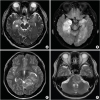1. Vargo M, Henriksson R, Salander P. Rehabilitation of patients with glioma. Handb Clin Neurol. 2016; 134:287–304.

2. Andrejeva J, Volkova OV. Physical and psychological rehabilitation of patients with intracranial glioma. Prog Neurol Surg. 2018; 31:210–228.

3. Shahpar S, Wong AWK, Keeshin S, Eickmeyer SM, Semik P, Kocherginsky M, McCarty S. Functional outcomes of an interdisciplinary outpatient rehabilitation program for patients with malignant brain tumors. PM R. 2018; 10:926–933.

4. Peurala SH, Airaksinen O, Huuskonen P, Jäkälä P, Juhakoski M, Sandell K, Tarkka IM, Sivenius J. Effects of intensive therapy using gait trainer or floor walking exercises early after stroke. J Rehabil Med. 2009; 41:166–173.

5. Langhorne P, Bernhardt J, Kwakkel G. Stroke rehabilitation. Lancet. 2011; 377:1693–1702.

6. Yang HE, Kyeong S, Lee SH, Lee WJ, Ha SW, Kim SM, Kang H, Lee WM, Kang CS, Kim DH. Structural and functional improvements due to robot-assisted gait training in the stroke-injured brain. Neurosci Lett. 2017; 637:114–119.

7. Mehrholz J, Thomas S, Werner C, Kugler J, Pohl M, Elsner B. Electromechanical-assisted training for walking after stroke. Cochrane Database Syst Rev. 2017; 5:CD006185.

8. Do KH, Chun MH. Clinical use of robots as a part of rehabilitation medicine. Brain Neurorehabil. 2017; 10:e7.

9. Ochi M, Wada F, Saeki S, Hachisuka K. Gait training in subacute non-ambulatory stroke patients using a full weight-bearing gait-assistance robot: a prospective, randomized, open, blinded-endpoint trial. J Neurol Sci. 2015; 353:130–136.

10. Demeurisse G, Demol O, Robaye E. Motor evaluation in vascular hemiplegia. Eur Neurol. 1980; 19:382–389.

11. Schwartz I, Sajin A, Fisher I, Neeb M, Shochina M, Katz-Leurer M, Meiner Z. The effectiveness of locomotor therapy using robotic-assisted gait training in subacute stroke patients: a randomized controlled trial. PM R. 2009; 1:516–523.

12. Pohl M, Werner C, Holzgraefe M, Kroczek G, Mehrholz J, Wingendorf I, Hoölig G, Koch R, Hesse S. Repetitive locomotor training and physiotherapy improve walking and basic activities of daily living after stroke: a single-blind, randomized multicentre trial (DEutsche GAngtrainerStudie, DEGAS). Clin Rehabil. 2007; 21:17–27.
13. Forlander DA, Bohannon RW. Rivermead mobility index: a brief review of research to date. Clin Rehabil. 1999; 13:97–100.

14. Péus D, Newcomb N, Hofer S. Appraisal of the Karnofsky performance status and proposal of a simple algorithmic system for its evaluation. BMC Med Inform Decis Mak. 2013; 13:72.

15. Mendoza TR, Wang XS, Cleeland CS, Morrissey M, Johnson BA, Wendt JK, Huber SL. The rapid assessment of fatigue severity in cancer patients: use of the brief fatigue inventory. Cancer. 1999; 85:1186–1196.
16. Morone G, Bragoni M, Iosa M, De Angelis D, Venturiero V, Coiro P, Pratesi L, Paolucci S. Who may benefit from robotic-assisted gait training? a randomized clinical trial in patients with subacute stroke. Neurorehabil Neural Repair. 2011; 25:636–644.
17. Tong RK, Ng MF, Li LS. Effectiveness of gait training using an electromechanical gait trainer, with and without functional electric stimulation, in subacute stroke: a randomized controlled trial. Arch Phys Med Rehabil. 2006; 87:1298–1304.

18. Wang XS, Woodruff JF. Cancer-related and treatment-related fatigue. Gynecol Oncol. 2015; 136:446–452.

19. Bower JE. Cancer-related fatigue--mechanisms, risk factors, and treatments. Nat Rev Clin Oncol. 2014; 11:597–609.

20. van Coevorden-van Loon EMP, Coomans MB, Heijenbrok-Kal MH, Ribbers GM, van den Bent MJ. Fatigue in patients with low grade glioma: systematic evaluation of assessment and prevalence. J Neurooncol. 2017; 133:237–246.








 PDF
PDF Citation
Citation Print
Print




 XML Download
XML Download